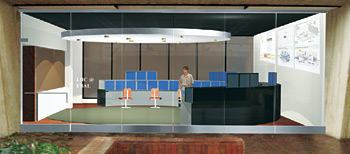Monitoring the LHC from across the ocean
 |
|
Illustration: Gary Van Zandbergen, Fermilab |
When the LHC collider and its experiments are being switched on in 2007, scientists around the world will be eager to monitor the start-up in real time. But physicists won't have to be at the LHC site to monitor the hardware they built or to determine what tuning they need to do.
Welcome to LHC@FNAL, a remote operations center at Fermilab, where scientists will find the same consoles and monitoring systems used 4400 miles away at the European laboratory CERN, the home of the LHC. To be constructed this fall, this center (opposite page) will give scientists real-time access to the vital data of the CERN accelerator complex as well as the CMS detector.
LHC@FNAL is a central component of the LHC Physics Center at Fermilab. Since not all US collaborators will be able to travel to CERN on a regular basis, the LHC Physics Center will offer particle physicists from US institutions the opportunity to meet and to work together as part of the international collaboration without the long flight across the Atlantic. Similarly, US accelerator scientists who are part of the LHC Accelerator Research Program (LARP) will be able to collaborate with their LHC counterparts in commissioning and monitoring US-provided magnets and instrumentation as well as participate in accelerator studies as part of the commissioning of the collider and future LHC upgrades.
"Almost everybody in the United States is able to fly to Fermilab for one day and then go back and teach the next day," says University of Maryland physicist Sarah Eno, who works on the CMS experiment. This summer, about 70 people are spending part of their time at the Fermilab LHC Physics Center, rather than CERN, to write software and to evaluate test data, getting the CMS detector ready for data taking.
Kurt Riesselmann
Click here to download the pdf version of this article.






